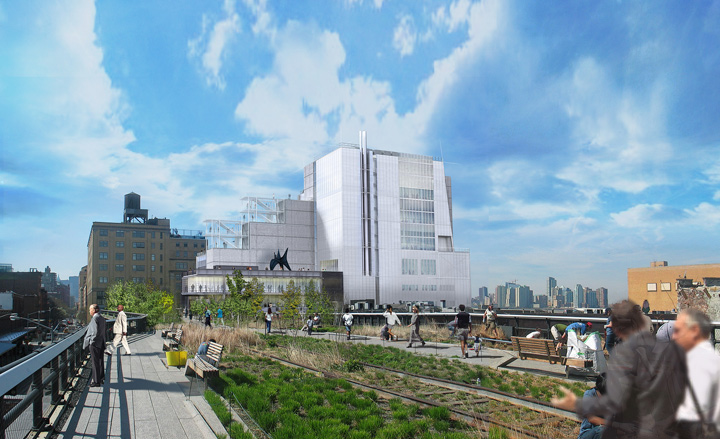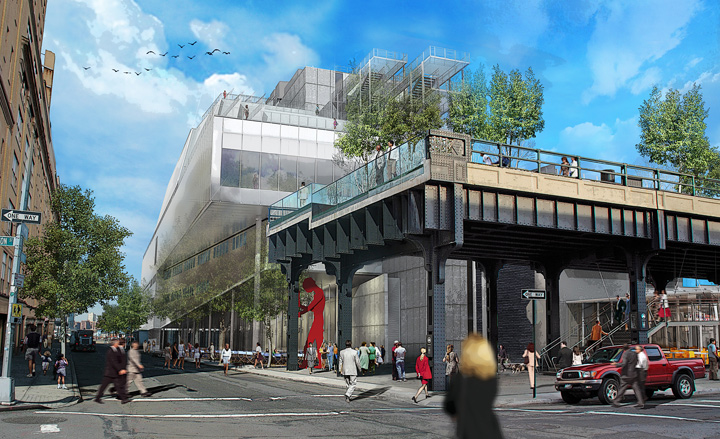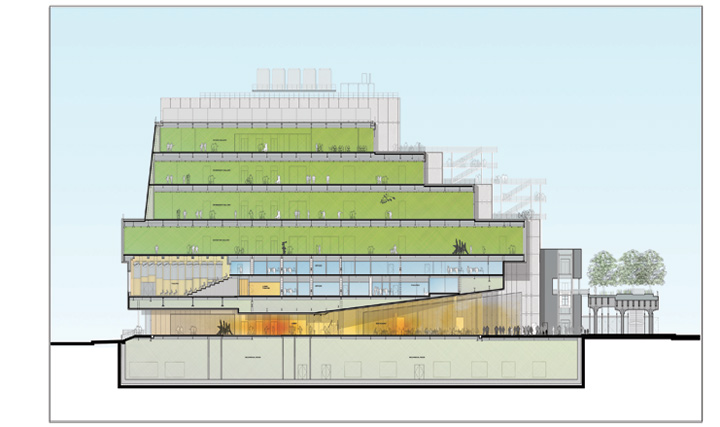Whitney Museum extension breaks ground

If you had the chance to head to the corner of Gansevoort and Washington streets in New York this morning, you were probably part of a moment in architectural history. The site, part of the Meatpacking district and adjacent to the southern entrance to the High Line, is soon going to host the Whitney Museum extension building, which, designed by Italian architect Renzo Piano, just broke ground.
The groundbreaking ceremony marks the start of works on the 200,000sq ft facility for the Museum, which will include extra space for collection, exhibitions, and education and performing arts programs as well as several more facilities, like a research library, a 170-seat theatre, a restaurant, café and bookstore.
The Pritzker Prize-winner's asymmetrical design will have a strong presence when finished. Sculptural and modern, it will also reflect the area's industrial character, while being set back unobtrusively from the High Line's park. A cantilevered entrance on Gansevoort Street will create a dramatic public plaza that can also be used for art display. Upon completion, the new special exhibition gallery will be the largest column-free museum gallery space in New York City. Further outdoor exhibition space will be provided on four different rooftop levels.
The new building will include 50,000 sq ft of indoor galleries and 13,000 sq ft of rooftop exhibition space, offering considerable breathing space to the original Madison Avenue Whitney's collection and temporary shows, as well as connecting strongly with the area; after all the museum was founded at nearby Greenwich Village, by Gertrude Vanderbilt Whitney in 1930.
Planned to be ready for the public in 2015, the new building will without a doubt be a valuable sibling to the original iconic 1966 Marcel Breuer-designed Whitney building on Madison Avenue. In the meantime, a series of performance and public art events will take place throughout the week.

The 200,000sq ft facility for the Museum, will include extra space for collection, exhibitions, and education and performing arts programs as well as several more facilities, like a research library, a 170-seat theatre, a restaurant, café and bookstore

The Pritzker Prize-winner's asymmetrical design will have a commanding presence

The new building includes 50,000 sq ft of indoor galleries and 13,000 sq ft of rooftop exhibition space, which will offer considerable breathing space to the original Madison Avenue Whitney

It is planned to be ready for the public in 2015
Receive our daily digest of inspiration, escapism and design stories from around the world direct to your inbox.
Ellie Stathaki is the Architecture & Environment Director at Wallpaper*. She trained as an architect at the Aristotle University of Thessaloniki in Greece and studied architectural history at the Bartlett in London. Now an established journalist, she has been a member of the Wallpaper* team since 2006, visiting buildings across the globe and interviewing leading architects such as Tadao Ando and Rem Koolhaas. Ellie has also taken part in judging panels, moderated events, curated shows and contributed in books, such as The Contemporary House (Thames & Hudson, 2018), Glenn Sestig Architecture Diary (2020) and House London (2022).
-
 Year in Review: we’re always after innovations that interest us – here are ten of 2025’s best
Year in Review: we’re always after innovations that interest us – here are ten of 2025’s bestWe present ten pieces of tech that broke the mould in some way, from fresh takes on guitar design, new uses for old equipment and the world’s most retro smartwatch
-
 Art and culture editor Hannah Silver's top ten interviews of 2025
Art and culture editor Hannah Silver's top ten interviews of 2025Glitching, coding and painting: 2025 has been a bumper year for art and culture. Here, Art and culture editor Hannah Silver selects her favourite moments
-
 In Norway, remoteness becomes the new luxury
In Norway, remoteness becomes the new luxuryAcross islands and fjords, a new wave of design-led hideaways is elevating remoteness into a refined, elemental form of luxury
-
 Step inside this resilient, river-facing cabin for a life with ‘less stuff’
Step inside this resilient, river-facing cabin for a life with ‘less stuff’A tough little cabin designed by architects Wittman Estes, with a big view of the Pacific Northwest's Wenatchee River, is the perfect cosy retreat
-
 Remembering Robert A.M. Stern, an architect who discovered possibility in the past
Remembering Robert A.M. Stern, an architect who discovered possibility in the pastIt's easy to dismiss the late architect as a traditionalist. But Stern was, in fact, a design rebel whose buildings were as distinctly grand and buttoned-up as his chalk-striped suits
-
 Own an early John Lautner, perched in LA’s Echo Park hills
Own an early John Lautner, perched in LA’s Echo Park hillsThe restored and updated Jules Salkin Residence by John Lautner is a unique piece of Californian design heritage, an early private house by the Frank Lloyd Wright acolyte that points to his future iconic status
-
 The Stahl House – an icon of mid-century modernism – is for sale in Los Angeles
The Stahl House – an icon of mid-century modernism – is for sale in Los AngelesAfter 65 years in the hands of the same family, the home, also known as Case Study House #22, has been listed for $25 million
-
 Houston's Ismaili Centre is the most dazzling new building in America. Here's a look inside
Houston's Ismaili Centre is the most dazzling new building in America. Here's a look insideLondon-based architect Farshid Moussavi designed a new building open to all – and in the process, has created a gleaming new monument
-
 Frank Lloyd Wright’s Fountainhead will be opened to the public for the first time
Frank Lloyd Wright’s Fountainhead will be opened to the public for the first timeThe home, a defining example of the architect’s vision for American design, has been acquired by the Mississippi Museum of Art, which will open it to the public, giving visitors the chance to experience Frank Lloyd Wright’s genius firsthand
-
 Clad in terracotta, these new Williamsburg homes blend loft living and an organic feel
Clad in terracotta, these new Williamsburg homes blend loft living and an organic feelThe Williamsburg homes inside 103 Grand Street, designed by Brooklyn-based architects Of Possible, bring together elegant interiors and dramatic outdoor space in a slick, stacked volume
-
 This ethereal Miami residence sprouted out of a wild, jungle-like garden
This ethereal Miami residence sprouted out of a wild, jungle-like gardenA Miami couple tapped local firm Brillhart Architecture to design them a house that merged Florida vernacular, Paul Rudolph and 'too many plants to count’